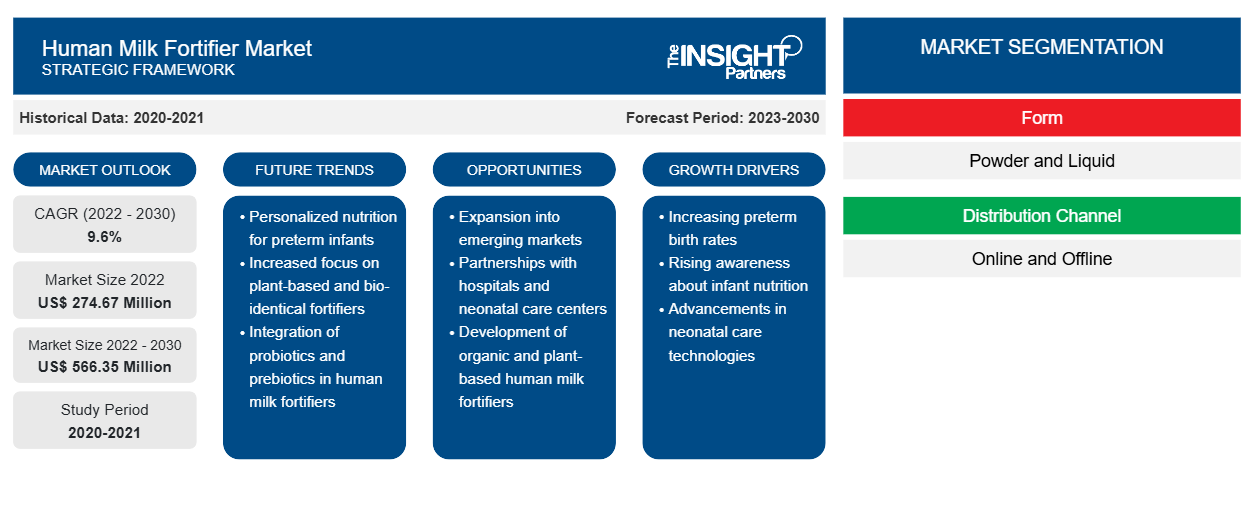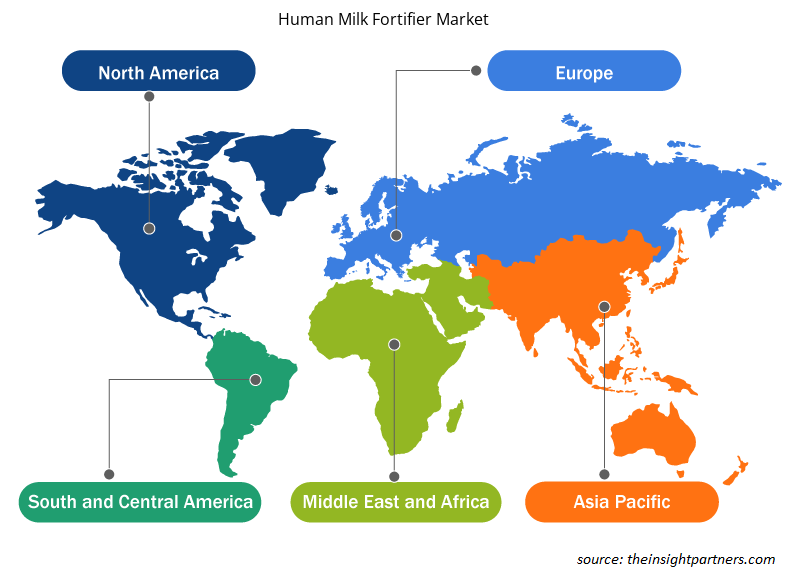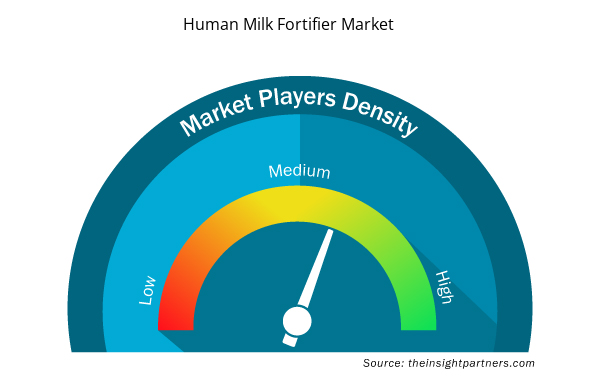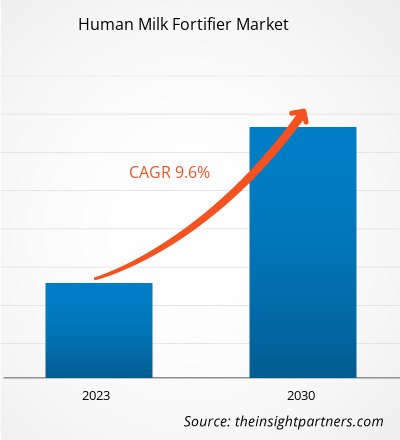[Research Report] The human milk fortifier market size is expected to grow from US$ 274.67 million in 2022 to US$ 566.35 million by 2030; it is estimated to register a CAGR of 9.6% from 2023 to 2030.
Market Insights and Analyst View:
Human milk fortifiers are nutritional supplements added to human milk to provide additional calories, electrolytes, and vitamins to infants. It is commonly prescribed to preterm babies in the neonatal intensive care unit (NICU) to ensure nutritional intake and improve overall development and growth. In addition, babies with low weight are also prescribed human milk fortifiers.
Growth Drivers and Challenges:
In recent years, the number of preterm births has increased owing to changing lifestyles and chronic diseases such as diabetes and high blood pressure. According to the Centers for Disease Control and Prevention (CDC), in 2021, preterm birth affected ~1 of every ten infants born in the US. The preterm birth rate in the US rose from 10.1% in 2020 to 10.5% in 2021. The World Health Organization (WHO) estimated that ~13.4 million babies were born in 2020. The preterm birth complication is the leading cause of death among children under five years of age, responsible for ~900,000 deaths in 2019. Preterm babies may have breathing problems, feeding difficulties, development delays, cerebral palsy, and vision and hearing problems.
The increasing number of preterm births has surged the demand for human milk fortifiers for the proper growth and development of infants. Many preterm infants need extra nutrients added to their mother's milk. They often need extra protein, calcium, phosphorous, and salt to build strong bones and healthy organs. Human milk fortifiers help provide these extra nutrients to infants. In human milk fortifiers, additional nutrients are added to the milk before it is fed to the babies. Thus, a surge in preterm births bolsters the human milk fortifier market growth.
Governments have imposed various rules and regulations related to the manufacturing and use of human milk fortifiers to ensure newborns' safety and maintain the product's quality standards. In Canada, human milk fortifiers are regulated under the Food and Drug Regulations (FDR). The FDR, Part B, Division 25 (B.25.019) rule is implemented to ensure the proper sales of human milk fortifiers under appropriate medical supervision. In addition, the human milk fortifier must provide Health Canada with premarket submission. Section B.25.011, subsections (a) to (n), specify the regulatory requirements for a new human milk fortifier. In the US, human milk fortifier is classified as exempt infant formula; however, the manufacturers have to meet the requirements of the US Food and Drug Administration (FDA), which ensures the nutrient declaration, including the amount of each mineral and vitamin listed in annexes of the product. Implementing such regulations has hampered human milk fortifier manufacturing, restraining market growth.
Customize This Report To Suit Your Requirement
You will get customization on any report - free of charge - including parts of this report, or country-level analysis, Excel Data pack, as well as avail great offers and discounts for start-ups & universities
Human Milk Fortifier Market: Strategic Insights

- Get Top Key Market Trends of this report.This FREE sample will include data analysis, ranging from market trends to estimates and forecasts.
Customize This Report To Suit Your Requirement
You will get customization on any report - free of charge - including parts of this report, or country-level analysis, Excel Data pack, as well as avail great offers and discounts for start-ups & universities
Human Milk Fortifier Market: Strategic Insights

- Get Top Key Market Trends of this report.This FREE sample will include data analysis, ranging from market trends to estimates and forecasts.
Report Segmentation and Scope:
The global human milk fortifier market is segmented into form, distribution channel, and geography. The human milk fortifier market is segmented into powder and liquid based on form. The human milk fortifier market is categorized online and offline based on distribution channels. The global human milk fortifier market is broadly segmented by geography into North America, Europe, Asia Pacific, the Middle East & Africa, and South & Central America.
Segmental Analysis:
Based on form, the human milk fortifier market is segmented into powder and liquid. The powder segment is expected to register a higher CAGR during the forecast period. Human milk fortifiers in the powdered form supplement and enhance the nutritional content of breast milk. Fortified breast milk is prescribed to premature or medically fragile infants. People prefer powdered human milk fortifiers for their convenience in storage, handling, and preparation. Moreover, they are easier to store and transport while ensuring a longer shelf life than liquid products.
Based on distribution channel, the human milk fortifier market is categorized into online and offline. The online segment is predicted to register a higher CAGR during the forecast period. Online retail stores are associated with the convenience of shopping from the comfort of one's home. Parents can browse and purchase human milk fortifiers at any time suitable for them without visiting a store. Also, online platforms often provide them access to a broad range of fortifiers, allowing parents to explore various options and choose the most suitable product. Furthermore, human milk fortifiers may be unavailable in local or specialty stores; online stores provide access to a more extensive inventory, making it easier for consumers to find specific brands unavailable in their locality. Customer reviews and detailed product information further help parents make more informed decisions. By reading reviews from other parents who have used the product, they can gain insights into its effectiveness and suitability. Online retailers frequently offer competitive prices due to lower overhead costs than physical stores. This can benefit users looking for economical options or comparing prices across different sellers. Furthermore, some users may prefer purchasing human milk fortifiers discreetly because they are sensitive about publicly discussing their baby's health. Online channels offer privacy and allow for discreet purchasing and delivery.
Regional Analysis:
Based on geography, the rice flour market is divided into five key regions: North America, Europe, Asia Pacific, South & Central America, and Middle East & Africa. The market in North America was valued at ~US$ 85.82 million in 2022. Asia Pacific is estimated to register a CAGR of ~10.4% during the forecast period. As disposable income levels rise in Asia Pacific, more parents can afford premium healthcare products, including human milk fortifiers. This has contributed to the market growth, as parents are willing to invest in products that can improve their child's health and well-being. Moreover, the expansion of healthcare infrastructure, including neonatal intensive care units (NICUs), across Asia Pacific has created a favorable environment for the human milk fortifier market growth. Hospitals and healthcare facilities are better equipped to provide specialized care for premature infants, increasing the demand for human milk fortifiers.
Human Milk Fortifier Market Regional Insights
Human Milk Fortifier Market Regional Insights
The regional trends and factors influencing the Human Milk Fortifier Market throughout the forecast period have been thoroughly explained by the analysts at Insight Partners. This section also discusses Human Milk Fortifier Market segments and geography across North America, Europe, Asia Pacific, Middle East and Africa, and South and Central America.

- Get the Regional Specific Data for Human Milk Fortifier Market
Human Milk Fortifier Market Report Scope
| Report Attribute | Details |
|---|---|
| Market size in 2022 | US$ 274.67 Million |
| Market Size by 2030 | US$ 566.35 Million |
| Global CAGR (2022 - 2030) | 9.6% |
| Historical Data | 2020-2021 |
| Forecast period | 2023-2030 |
| Segments Covered |
By Form
|
| Regions and Countries Covered | North America
|
| Market leaders and key company profiles |
Human Milk Fortifier Market Players Density: Understanding Its Impact on Business Dynamics
The Human Milk Fortifier Market market is growing rapidly, driven by increasing end-user demand due to factors such as evolving consumer preferences, technological advancements, and greater awareness of the product's benefits. As demand rises, businesses are expanding their offerings, innovating to meet consumer needs, and capitalizing on emerging trends, which further fuels market growth.
Market players density refers to the distribution of firms or companies operating within a particular market or industry. It indicates how many competitors (market players) are present in a given market space relative to its size or total market value.
Major Companies operating in the Human Milk Fortifier Market are:
- Abbott Laboratories
- NeoLacta Lifesciences Pvt Ltd
- Nestle SA
- Prolacta Bioscience Inc
- Lead Care International Ltd
Disclaimer: The companies listed above are not ranked in any particular order.

- Get the Human Milk Fortifier Market top key players overview
Industry Developments and Future Opportunities:
Various initiatives taken by the key players operating in the human milk fortifier market are listed below:
- In January 2022, Prolacta Bioscience introduced human milk fortifiers in Japan. The launch was aimed at entering the untapped market in the country and helping improve the health of newborns. In November 2020, Lifeblood Milk and the South Australian Health and Medical Research Institute (SAHMRI) entered into collaboration with CSIRO, Australia's national science agency. The partnership aimed to develop human milk fortifiers to improve nutrition and growth in preterm babies.
- In September 2021, Neolacta Lifesciences Pvt. Ltd launched its products on e-commerce platforms to ensure easy availability of its products such as Neolacta Human Breast Milk and Neolacta MMF (Mother's Milk Fortifier) to parents.
Covid-19 Impact:
The COVID-19 pandemic initially affected the global human milk fortifier market due to the shutdown of manufacturing units, shortage of labor, disruption of supply chains, and financial instability. The disruption of various industries due to the economic slowdown caused by the COVID-19 outbreak restrained the demand for human milk fortifiers. However, businesses are gaining ground as previously imposed limitations have been eased across various countries. Moreover, the introduction of COVID-19 vaccines by governments of different countries eased the situation, leading to a rise in business activities worldwide. Several markets, including the human milk fortifier market, witnessed growth after the ease of lockdowns and movement restrictions.
Competitive Landscape and Key Companies:
Some of the prominent players operating in the global human milk fortifier market include Abbott Laboratories, NeoLacta Lifesciences Pvt Ltd, Nestle SA, Prolacta Bioscience Inc, Lead Care International Ltd, Raptakos, Brett & Co Ltd, NeoKare Nutrition Ltd, Danone SA, Neolac Inc, and Reckitt Benckiser Group Plc.
- Historical Analysis (2 Years), Base Year, Forecast (7 Years) with CAGR
- PEST and SWOT Analysis
- Market Size Value / Volume - Global, Regional, Country
- Industry and Competitive Landscape
- Excel Dataset


- Explosion-Proof Equipment Market
- Batter and Breader Premixes Market
- Artwork Management Software Market
- Smart Locks Market
- Aquaculture Market
- Excimer & Femtosecond Ophthalmic Lasers Market
- Resistance Bands Market
- Airline Ancillary Services Market
- Vaginal Specula Market
- Medical and Research Grade Collagen Market

Report Coverage
Revenue forecast, Company Analysis, Industry landscape, Growth factors, and Trends

Segment Covered
Form, Distribution Channel, and Geography

Regional Scope
North America, Europe, Asia Pacific, Middle East & Africa, South & Central America

Country Scope
Argentina, Australia, Brazil, Canada, China, France, Germany, India, Italy, Japan, Mexico, Russian Federation, Saudi Arabia, South Africa, South Korea, United Arab Emirates, United Kingdom, United States
Frequently Asked Questions
Based on the distribution channel, online segment is predicted to register the highest CAGR during the forecast period. Online retail stores are associated with the convenience of shopping from the comfort of one's home. Parents can browse and purchase human milk fortifiers at any time suitable for them without physically visiting a store. Also, online platforms often provide them access to a broad range of fortifiers, allowing parents to explore various options and choose the most suitable product. Furthermore, human milk fortifiers may be unavailable in local or specialty stores; online stores provide access to a more extensive inventory, making it easier for consumers to find specific brands that are unavailable in their locality. Customer reviews and detailed product information further help parents make more informed decisions. By reading reviews from other parents who have used the product, they can gain insights into its effectiveness and suitability.
Based on the form, the powder segment is expected to register the highest CAGR during the forecast period. Human milk fortifiers in the powdered form, supplement and enhance the nutritional content of breast milk. Fortified breast milk is prescribed to premature or medically fragile infants. People prefer powdered human milk fortifiers due to their convenience in terms of storage, handling, and preparation. Moreover, they are easier to store and transport while ensuring a longer shelf life than liquid products. Powdered human milk fortifiers are often more cost-effective than liquid forms. They typically come in larger quantities, allowing the preparation of multiple servings from a single container, thus reducing the overall cost.
Human milk fortifiers are recommended for preterm babies, underweight infants, and infants having nutritional deficiencies. Providing human milk fortifiers to infants that have started to suckle at the breast can be challenging for the mother and might shorten the duration of the breastfeeding period. Hence, feeding techniques such as cup feeding, supplemental nursing system (SNS), and finger feeder method are introduced to increase the use of fortifiers in infants after discharge from hospitals. Cup feeding is one of the safe fortifier feeding but cannot be used during nursing. Supplement nursing system is another alternative for providing human milk fortifiers during breastfeeding. However, this system is difficult to handle and requires nursing experience to feed the baby. The finger feeder method enables mothers to breastfeed their infants and meet their nutritional needs. In this method, handling and preparation of fortifiers is easy. According to the study conducted by Nestle Nutritional Institute, more than 67% of infants accepted devices and fortifiers during nursing. Further, efforts are being made to develop ready-to-use, liquid human milk fortifier mixtures that can be directly fed during breast feeding. Thus, the new ways of feeding fortifiers are expected to introduce new trends into the human milk fortifier market during the forecast period..
In 2022, North America region accounted for the largest share of the global human milk fortifier market and the market in the region is segmented into United States, Canada, and Mexico. North America has observed a rise in the preterm birth rate in recent years. Preterm infants are at higher risk of nutritional deficiencies and require specialized nutrition to support their growth and development. Human milk fortifiers are crucial in meeting the nutritional needs of these infants, which has led to increased demand for such products. Also, developing advanced human milk fortifiers with improved formulations and enhanced nutritional profiles has contributed to market growth. Manufacturers have invested in research and development to create fortifiers that offer optimal nutrition for preterm infants. These advancements have increased the effectiveness and acceptance of human milk fortifiers among healthcare providers and parents.
The major players operating in the global human milk fortifier market are Abbott Laboratories, NeoLacta Lifesciences Pvt Ltd, Nestle SA, Prolacta Bioscience Inc, Lead Care International Ltd, Raptakos, Brett & Co Ltd, NeoKare Nutrition Ltd, Danone SA, Neolac Inc, and Reckitt Benckiser Group Plc.
In recent years, the number of preterm births has increased owing to changing lifestyles, and chronic diseases such as diabetes and high blood pressure. According to the Centers for Disease Control and Prevention (CDC), in 2021, preterm birth affected ~1 of every ten infants born in the US. The preterm birth rate in the US rose from 10.1% in 2020 to 10.5% in 2021. The World Health Organization (WHO) estimated that ~13.4 million babies were born in 2020. The preterm birth complication is the leading cause of death among children under five years of age, responsible for ~900,000 deaths in 2019. Preterm babies may have breathing problems, feeding difficulties, development delays, cerebral palsy, and vision and hearing problems. The increasing number of preterm births has surged the demand for human milk fortifiers for the proper growth and development of infants. Many preterm infants need extra nutrients added to their mother’s milk. They often need extra protein, calcium, phosphorous, and even salt to build strong bones and healthy organs. Human milk fortifiers help provide these extra nutrients to infants. In human milk fortifiers, additional nutrients are added to the milk before it is fed to the babies. Thus, a surge in the number of preterm births is bolstering the human milk fortifier market growth.
Trends and growth analysis reports related to Food and Beverages : READ MORE..
The List of Companies - Human Milk Fortifier Market
- Abbott Laboratories
- NeoLacta Lifesciences Pvt Ltd
- Nestle SA
- Prolacta Bioscience Inc
- Lead Care International Ltd
- Raptakos, Brett & Co Ltd
- NeoKare Nutrition Ltd
- Danone SA
- Neolac Inc
- Reckitt Benckiser Group Plc

 Get Free Sample For
Get Free Sample For